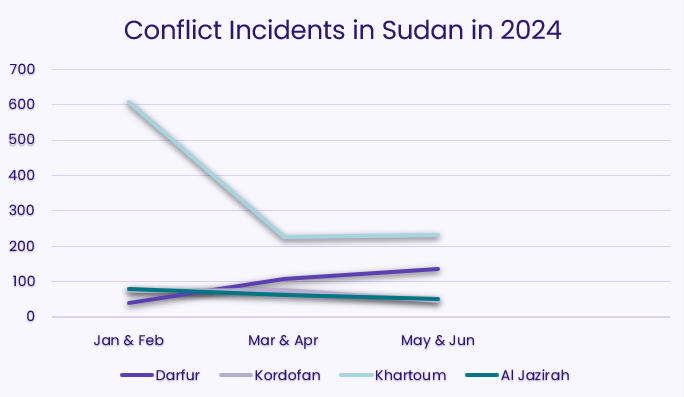Associate Analyst, Oliver Denning, examines the tragic consequences of the Sudanese civil war. It’s impact on Sudan is severe, but it is increasingly being felt further afield. Despite its high costs, the prospects for peace appear limited. This entails numerous concerns for East Africa and companies with operations in the region.
Sudan has been engulfed in conflict since April 2023, with rival factions battling for control. The conflict, primarily between Abdel Fattah al-Burhan and Mohamed Hamdan Dagalo (Hemedti), has expanded beyond Khartoum and Darfur. For a deeper understanding of the war’s impact explore the full article below.
Denning notes the tragic consequences of the Sudanese civil war. The war has displaced over 8 million people, exacerbating Sudan’s already dire humanitarian situation. The World Bank estimates that Sudan’s economy shrank by 12% in 2023, with an additional 18% contraction expected in 2024. The economic collapse surpasses the impact seen in Syria and Yemen, raising concerns about Sudan’s future stability. The severity of the crisis makes has made aid delivery increasingly difficult.
Urban centers like Khartoum and Omdurman are now devastated. The destruction extends to Sudan’s infrastructure, making aid delivery nearly impossible in regions like Darfur. Up to 80% of hospitals in conflict areas are non-functional, worsening the health crisis. The United Nations reported nearly 10,000 cholera cases and over 200 deaths in 2023 alone.

Sudan’s civil war threatens to destabilise the region: nearly 2 million refugees have fled to neighboring countries. Egypt, Chad, and South Sudan, already struggling with their challenges, are now facing additional pressures. The refugee influx has led to rising tensions and opportunistic crime, particularly in Chad and South Sudan.
Ethiopia, grappling with its own internal conflict, has also seen an influx of Sudanese refugees. The proximity of these conflicts to the Red Sea, a vital global trade route, raises concerns about potential disruptions. If violence escalates in Ethiopia, the impact on international trade could be severe.
The prolonged conflict in Sudan creates opportunities for extremist groups to exploit the chaos. The Sahel region, stretching from the Atlantic Ocean to the Red Sea, is already experiencing high levels of violence. Countries like Chad, rich in mineral wealth, are particularly vulnerable to extremist activity. Chad’s resources, including oil and gold, are prime targets for groups seeking to fund their operations.
The Sudanese civil war could have far-reaching global implications. An increase in migration across the Mediterranean could fuel the rise of right-wing populism in Europe. Sudan, Eritrea, and Somalia are major sources of migrants attempting to reach Europe. The worsening conflict in Sudan is likely to increase these numbers, straining relations within the European Union.
Despite the devastation, the prospect of peace in Sudan appears slim. Both al-Burhan and Hemedti have significant external support, particularly from Russia’s Wagner Group. Hemedti’s control over Darfur’s gold mines and other resources provides him with substantial wealth. This external backing allows both factions to sustain the conflict beyond Sudan’s own resources.
Without a swift resolution, the suffering in Sudan will only worsen, with far-reaching consequences for the region and beyond. For a deeper understanding of the consequences explore the full article below.
Monitor Refugee Flows: Regularly track the movement of refugees across borders, particularly into Chad and South Sudan. Increased refugee flows can heighten the risk of ethnic violence, civil unrest, and strain resources in these regions.
Evaluate Contingency Plans: Ensure all contingency and evacuation plans are up-to-date. Consider multiple viable evacuation routes, accounting for the rapid deterioration of infrastructure and escalating violence.
Montitor the state of the civil war: Ensure to keep up to date with developments in the civil war. Upticks in violence tend to precipitate increased refugee flows.
Enhance Physical Security: Strengthen security measures at facilities, especially those near conflict zones like Darfur. This includes reinforcing structures, securing supply lines, and ensuring safe rooms are available and well-equipped.
Prepare for Civil Unrest: Be aware of the likelihood of civil unrest in regions with high refugee influxes. Protests and clashes may disrupt operations and travel, particularly in major cities across affected regions.
Monitor reports of terrorism: Monitor news sources as terror groups may expand their operations in the region. Such developments increase the need increased static and mobile security.
Conduct Regular Drills: Implement regular emergency drills that simulate civil unrest and rioting. Ensure all personnel are familiar with their roles, responsibilities, and communication protocols during such a scenario.
Secure Supply Chains: Evaluate potential disruptions in supply chains. Source locations facing an influx of refugees are vulnerable to civil unrest and ethnic violence, which may disrupt logistics. Consider viablle opportunities in less volatile regions.
Establish a local fixer: Ensure to have local contacts who can keep you updated with reports of ongoing tensions and grievances in the vicinity. This can pre-empt ethnic violence civil unrest.
Leave a comment below or ask us directly. For more information on our bespoke risk management services, book a call today. Order custom analyst papers like our Traveller Insight to stay informed and ahead of the curve.